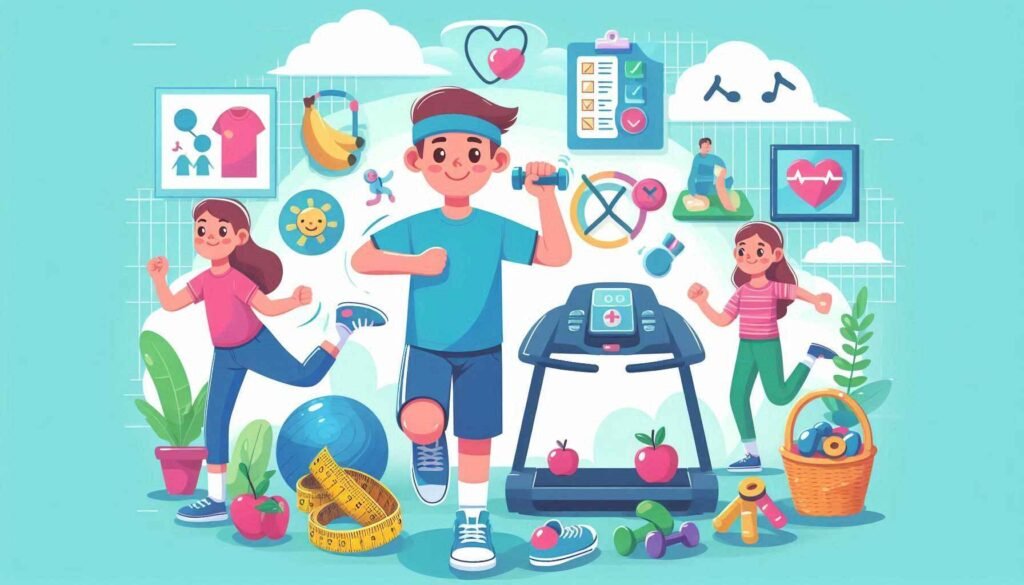
How to Encourage Physical Activity in Children and Teens: Practical Tips for Parents
In a world filled with screens and busy schedules, it can be challenging to encourage children and teens to stay active. Yet, physical activity is crucial for their overall health, aiding in physical development, mental well-being, and creating lifelong healthy habits. If you’re a parent or caregiver looking for ways to get your kids moving, this guide offers practical strategies to inspire and engage them in regular physical activity.
The Importance of Physical Activity for Children and Teens
In the digital age, kids and teens spend a significant amount of time sitting—whether it’s in school, doing homework, or scrolling through social media. The average teen spends up to nine hours a day in front of a screen. This sedentary lifestyle can have negative effects on both physical and mental health. Encouraging your child to stay active can help them build strong muscles, maintain a healthy weight, improve mental clarity, and reduce the risk of chronic diseases like obesity and diabetes.
Moreover, the benefits of physical activity go beyond physical health. Exercise releases endorphins, the “feel-good” hormones that help alleviate stress and anxiety. For teens, who may be navigating the pressures of school, social life, and the challenges of growing up, physical activity can serve as a crucial outlet for stress and emotional balance.
How Much Activity Is Enough?
According to the Department of Health and Human Services, children and teens need at least 60 minutes of moderate to vigorous activity every day. This activity should include:
- Aerobic activities like running, biking, or swimming, which are great for heart health.
- Muscle-strengthening exercises such as climbing, push-ups, or gymnastics.
- Bone-strengthening activities like jumping, dancing, or playing basketball.
The key is variety—incorporating different types of activities helps children develop various physical skills and keeps things exciting. However, getting kids to engage in these activities can sometimes feel like an uphill battle. So, how do you make physical activity appealing?
1. Make Exercise Fun and Engaging
Children are naturally playful, so leverage that to your advantage. Making exercise fun is one of the best ways to encourage physical activity without it feeling like a chore. Here are a few ideas:
- Organize family games or sports: Play soccer in the backyard, go for a family bike ride, or organize a neighborhood game of tag. The key is to participate as a family so that it becomes a shared activity.
- Turn chores into games: Have your kids race to see who can pick up toys the fastest or who can help mow the lawn in the most creative way. Physical tasks don’t have to be boring—they can be part of the fun.
- Encourage variety: Trying different sports or activities allows children to discover what they enjoy the most. Whether it’s martial arts, dancing, swimming, or skateboarding, the options are endless. When kids find an activity they love, they’re more likely to stick with it.
2. Set a Positive Example
Children often mirror their parents’ behaviors, so be a role model when it comes to staying active. Show them that physical activity is a priority in your life, whether through daily walks, gym sessions, or yoga. Discuss the benefits you experience—improved mood, better energy, and stress relief—so they can see the personal value of exercise. When they see you being active, they’re more likely to follow your lead.
You can also make it a family affair. Set aside time for group activities like hiking, swimming, or playing basketball together. This not only gets everyone moving but also strengthens family bonds.
3. Limit Screen Time
The biggest competitor to physical activity is screen time. Kids are often glued to their phones, tablets, or video games, making it difficult to pull them away for outdoor activities. Establish screen time limits and encourage breaks from digital devices. A good way to implement this is by creating a “no screen time” rule for certain hours of the day or offering screen time as a reward after they’ve spent time being active.
To reduce pushback, offer alternatives to screen-based entertainment. Suggest outdoor play, craft activities, or reading as substitutes. And don’t forget to model this behavior yourself—limiting your own screen time sets a good example.
4. Set Realistic Goals and Track Progress
Setting goals can be a powerful motivator for children and teens. Whether it’s mastering a new skill in a sport, reaching a personal best in running, or simply increasing daily steps, having something to work toward encourages consistency.
Consider setting up family fitness challenges where everyone participates and tracks their progress. Celebrate milestones with small rewards like a trip to the movies or a special family outing. When kids see tangible progress and receive recognition for their efforts, they’ll feel more motivated to continue.
5. Incorporate Movement into Daily Routines
Not all physical activity has to be structured or involve organized sports. In fact, small changes to your daily routine can add up to significant physical activity. Here are some simple ways to do this:
- Walk or bike to school instead of driving if it’s safe and feasible.
- Encourage your kids to take the stairs rather than the elevator.
- Make family walks after dinner a regular part of your routine.
- Have a quick dance party in the living room to their favorite songs.
These small bursts of activity can become habits that promote long-term health and well-being.
6. Encourage Group Sports and Social Play
Many children and teens enjoy group sports for the social interaction as much as the physical challenge. If your child is interested, explore team sports such as soccer, basketball, or gymnastics. These activities can build teamwork, communication skills, and self-discipline. However, not all kids thrive in competitive sports, so it’s important to recognize their preferences.
For children who shy away from group settings, consider individual sports like tennis, swimming, or cycling. These allow for personal achievement without the pressures of team competition. The key is to support their interests and avoid forcing them into activities they don’t enjoy.
7. Nutrition Matters: Fuel Their Bodies
A child’s energy level is closely tied to their diet. To ensure they have the stamina to engage in physical activity, provide nutritious meals that fuel their bodies. Encourage whole foods like fruits, vegetables, lean proteins, and whole grains. Reducing refined sugars and processed foods can significantly boost their energy levels, making them more eager to participate in physical activities.
Involving kids in meal prep is also a great way to teach them about nutrition and how it impacts their energy and health. When they understand the connection between food and fitness, they’re more likely to make healthy choices.
8. Adapt Activities for All Abilities
Some children may have physical or developmental challenges that make certain types of activity difficult. That doesn’t mean they can’t be active. Adapt activities to suit their abilities and interests. Swimming, wheelchair sports, or adaptive dance classes can provide fun and inclusive options for children with special needs.
The goal is to find activities that your child can enjoy and feel successful in. Consult with healthcare professionals or coaches who specialize in adaptive sports if you need guidance.
9. Stay Consistent and Patient
Encouraging physical activity isn’t always easy, and it’s normal for kids and teens to resist at times. The key is to stay consistent and be patient. Continue to offer opportunities for them to move, and celebrate small victories along the way. As physical activity becomes part of their routine, they’ll start to appreciate the benefits and may even begin to seek out ways to be more active on their own.
10. The Long-Term Benefits of Active Lifestyles
The habits children form in their youth often carry over into adulthood. Encouraging regular physical activity not only promotes their current health but sets the stage for a healthier future. Active kids are more likely to grow into active adults, reducing their risk of chronic diseases like heart disease, diabetes, and obesity.
By fostering a love of movement and activity now, you’re giving your children the tools they need to lead a healthy, balanced life for years to come.
Conclusion
Getting children and teens to embrace physical activity may seem challenging, but with a little creativity and patience, it can be done. By making exercise fun, limiting screen time, setting a good example, and celebrating small successes, you’ll inspire them to move more and enjoy the many benefits of an active lifestyle. Remember, the goal is to help them develop a lifelong love of physical activity that will keep them healthy and happy for years to come.



